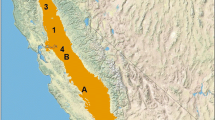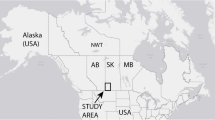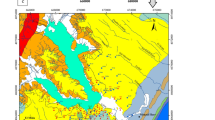Abstract
This work was motivated by considerations of potential leakage pathways for CO2 injected into deep geological formations for the purpose of carbon sequestration. Because existing wells represent a potentially important leakage pathway, a spatial analysis of wells that penetrate a deep aquifer in the Alberta Basin was performed and various statistical measures to quantify the spatial distribution of these wells were presented. The data indicate spatial clustering of wells, due to oil and gas production activities. The data also indicate that the number of wells that could be impacted by CO2 injection, as defined by the spread of an injected CO2 plume, varies from several hundred in high well-density areas to about 20 in low-density areas. These results may be applied to other mature continental sedimentary basins in North America and elsewhere, where detailed information on well location and status may not be available.









Similar content being viewed by others
References
Bachu S (2002) Sequestration of CO2 in geological media in response to climate change: road map for site selection using the transform of the geological space into the CO2 phase space. Energy Convers Manag 43:87–102
Bachu S (2003) Screening and ranking of sedimentary basins for sequestration of CO2 in geological media. Environ Geol 44:277–289
Bachu S, Stewart S (2002) Geological sequestration of anthropogenic carbon dioxide in the western Canada sedimentary basin: suitability analysis. J Can Petr Tech 41(2):32–40
Bachu S, Adams JJ (2003) Sequestration of CO2 in geological media in response to climate change: capacity of deep saline aquifers to sequester CO2 in solution. Energy Convers Manag 44:3151–3175
Bachu S, Shaw J (2003) Evaluation of the CO2 sequestration capacity in Alberta’s oil and gas reservoirs at depletion, and the effect of underlying aquifers. J Can Petr Tech 42(9):51–61
Bachu S, Gunter WD, Perkins EH (1994) Aquifer disposal of CO2–hydrodynamic and mineral trapping. Energy Convers Manag 35(4):269–279
Bruant RG, Guswa AJ, Celia MA, Peters CA (2002) Safe storage in deep saline aquifers. Env Sci Tech 36:241A-245A
Celia MA, Bachu S (2003) Geological sequestration of CO2: Is leakage unavoidable and acceptable? In: Gale J, Kaya Y (eds) Proc 6th International Greenhouse Gas Control Technologies, Kyoto, Japan, 1–5 Oct 2002. Pergamon, New York, pp 477–482
EIA (Energy Information Administration) (2000) International Energy Annual 2000. Tech Rep DOE/EIA-0219
EUB (Alberta Energy and Utilities Board) (1982) Drilling spacing units and target areas requirements clarified. EUB Information Letter 82–4
Farrar CD, Sorey ML, Evans WC, Howle JF, Kerr BD, Kennedy BM, King CY, Southon JR (1995) Forest-killing diffuse hCO2 emission at Mammoth Mountain as a sign of magmatic unrest. Nature 376:675–678
Farrar CD, Neil JM, Howle JF (1999) Magmatic carbon dioxide emissions at Mammoth Mountain, California. USGS Water-Resources Investigative Report No 98–4217
Gunter WD, Wiwchar B, Perkins EH (1997) Aquifer disposal of CO2-rich greenhouse gases: extension of the time scale of experiment for CO2-sequestering reactions by geochemical modelling. Mineralogy Petrology 59:121–140
Gurevich AE, Endres BL, Robertson Jr JO, Chilingar GV (1993) Gas migration from oil and gas fields and associated hazards. J Petr Sci Eng 9:223–238
Hitchon B (ed) (1996) Aquifer disposal of carbon dioxide: Hydrodynamic and mineral trapping–proof of concept. Geosciences Publications: Sherwood Park, Alta, Canada
Holloway S (2001) Storage of fossil fuels-derived carbon dioxide beneath the surface of the earth. Ann Rev Energy Env 26:145–166
Houghton JT, Ding Y, Griggs DJ, Noguer M, van der Linden PJ, Xiaosu D (eds) (2001) Climate Change 2001: The Scientific Basis, Third assessment report of the Intergovernmental Panel on Climate Change. Cambridge University Press, New York, pp 1–994
Keeling CD, Whorf TP (1998) Atmospheric concentrations–Mauna Loa Observatory, Hawaii, 1958–1997 (revised August 1998). Carbon Dioxide Analysis Center, Oak Ridge National Laboratory, Tech Rep NDP-001
Lindeberg E (1997) Escape of CO2 from aquifers. Energy Convers Manag 38S: S235-S240
Masters JA (1979) Deep basin gas trap, western Canada. Am Assoc Petrol Geol Bull 63:39–77
Pacala SW (2003) Global constraints on reservoir leakage. In: Gale J, Kaya Y (eds) Proc 6th International Greenhouse Gas Control Technologies, Kyoto, Japan, 1–5 Oct 2002. Pergamon, New York, pp 267–272
Sarmiento JL (1993) Ocean carbon cycle. Chem Eng News 71:30–43
Sarmiento JL, Quéré CL, Pacala SW (1995) Limiting future atmospheric carbon dioxide. Global Biogeochem Cycles 9:121–138
Socolow R (1997) Fuels decarbonization and carbon sequestration: Report of a workshop. Center for Energy and Environmental Studies Rep No PU/CEES 302
St John B, Bally AW, Klemme HD (1984) Sedimentary provinces of the world – Hydrocarbon productive and nonproductive. American Association of Petroleum Geologists, Tulsa, OK
Xu TF, Apps JA, Pruess K (2003) Reactive geochemical transport simulation to study mineral trapping for CO2 disposal in arenaceous formations. J Geophys Res 108(B2):2071
Acknowledgements
This work was supported in part through funding provided by BP and Ford Motor Company to the Carbon Mitigation Initiative at Princeton University, and by a graduate fellowship to S. Gasda from the National Science Foundation.
Author information
Authors and Affiliations
Corresponding author
Rights and permissions
About this article
Cite this article
Gasda, S.E., Bachu, S. & Celia, M.A. Spatial characterization of the location of potentially leaky wells penetrating a deep saline aquifer in a mature sedimentary basin. Env Geol 46, 707–720 (2004). https://doi.org/10.1007/s00254-004-1073-5
Received:
Accepted:
Published:
Issue Date:
DOI: https://doi.org/10.1007/s00254-004-1073-5




